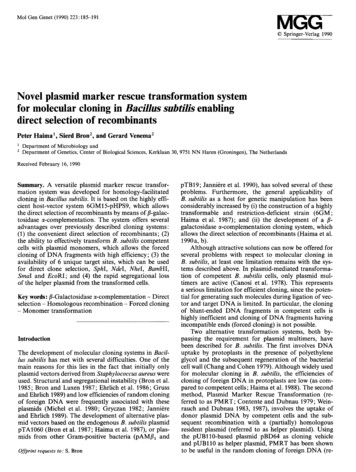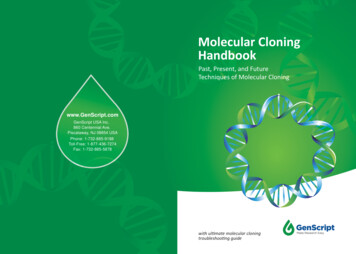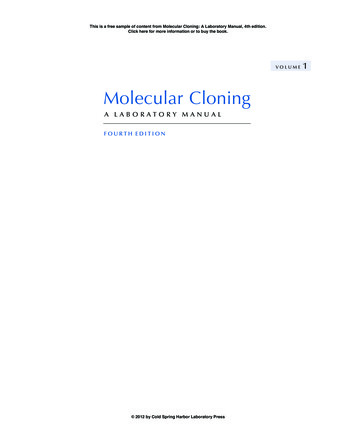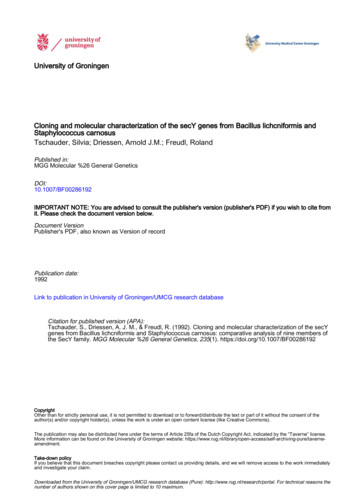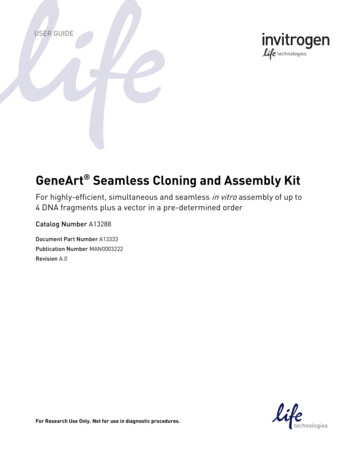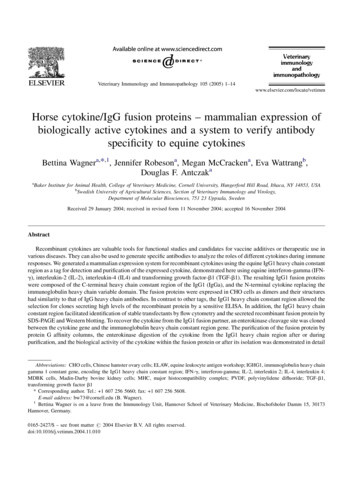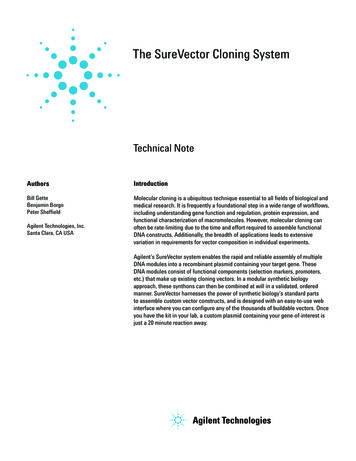
Transcription
The SureVector Cloning SystemTechnical NoteAuthorsIntroductionBill GetteBenjamin BorgoPeter SheffieldMolecular cloning is a ubiquitous technique essential to all fields of biological andmedical research. It is frequently a foundational step in a wide range of workflows,including understanding gene function and regulation, protein expression, andfunctional characterization of macromolecules. However, molecular cloning canoften be rate-limiting due to the time and effort required to assemble functionalDNA constructs. Additionally, the breadth of applications leads to extensivevariation in requirements for vector composition in individual experiments.Agilent Technologies, Inc.Santa Clara, CA USAAgilent’s SureVector system enables the rapid and reliable assembly of multipleDNA modules into a recombinant plasmid containing your target gene. TheseDNA modules consist of functional components (selection markers, promoters,etc.) that make up existing cloning vectors. In a modular synthetic biologyapproach, these synthons can then be combined at will in a validated, orderedmanner. SureVector harnesses the power of synthetic biology’s standard partsto assemble custom vector constructs, and is designed with an easy-to-use webinterface where you can configure any of the thousands of buildable vectors. Onceyou have the kit in your lab, a custom plasmid containing your gene-of-interest isjust a 20 minute reaction away.
Key advantages of the innovative SureVectorsystem include:The SureVector core kit provides functionality in E.coli, yeast, and mammalian cells (Figure 1). The twoexpansion slots (XP1 and XP2) expand utility beyondbacteria to yeast and mammalian systems. If theyeast and mammalian modules are not used, the XP1and XP2 linkers are used to close the plasmid circle.Also included in the core kit (p/n G7514A) are allof the buffers, enzymes and nucleotides required togenerate SureVector plasmids, as well as XL1-Bluesupercompetent cells. Assembly of a SureVector plasmidfrom Agilent’s standardized DNA modules takes only20 minutes in a single-tube reaction. Total hands-ontime including transformation is less than two hours.With the SureVector core kit, up to 216 different vectorscan be created, and all steps downstream from theassembly are the same as traditional cloning procedures.The ease with which custom SureVectors can be builtintegrates seamlessly with your existing workflow.While SureVector offers “scarless”, one-pot, rapid vectorassembly like alternative next-gen systems, it is muchmore efficient when assembling more than 5 modules,and in fact as many as 7 modules can be assembledeffectively using SureVector. Rapid custom vector generation – less than a day fromdesign to vector, compared to 4 weeks for customvector services Enhanced flexibility – assemble new vectors quickly asexperimental requirements change, rather than havingto order new ones Control of experiments – get the construct you wantwhen you need it, rather than settling for what acatalog can provide Reliable and precise assembly – SureVector has beenextensively validated to ensure that standard partscan be interchanged without loss of functionality,and it is the only next-generation plasmid assemblytechnology to guarantee assembly of multiplefunctional DNA fragmentsThis technical overview illustrates the utility and reliabilityof the SureVector system by demonstrating the validationof the system for construction of bacterial, mammalianand yeast cloning vectors.XP2 EXPANSIONXP2 LinkerNeoRLacI LEU2The KitXP2The SureVector Core Kit has seven components:XP1 ExpansionSelectable MarkerOrigin-of-ReplicationGene-of-Interest (GOI)PromotorPromoter-TagXP1 16 DNA modules divided into 6 functional groupsXP2 ExpansionGOI USER SUPPLIEDXP1 EXPANSIONyARSXP1 LinkerRep li cBACTERIAL REPLICATIONFRAGMENTpUCp15ApBR322 dNTPs SureSolution (5x) XL1-Blue Chemically Supercompetent CellsleMginof SureVector buffer (10x)arkO ri SureVector Enzyme mixer Dpn I enzymePROMOTER-TAGPT7-His (Bacterial)PCMV-His (Mammalian)PGall-His (Yeast)a ti o ncS eletabMARKER FRAGMENTAmpRkanRChlrRFigure 1. Structure of the SureVector cloning system.2
Efficient and High Fidelity AssemblyFour test vector assemblies were generated whichutilized all of the modules in all six DNA functionalgroups at least once (Table 1). The vectors wereassembled in silico using the SureVector softwaretool (http://www.genomics.agilent.com/surevector)prior to the actual assembly process (Figure 2). For eachof these assemblies, lacZ was inserted into the GOI slotas a positive control. The negative control was assembledin the absence of a GOI. In this case, a circular plasmidshould not be formed, and very few transformed coloniesshould be observed.Figure 3 shows the results of the transformationsperformed with the four test assemblies. In eachcase and across all three operators performing theexperiment, transformation efficiency was very highusing the lacZ gene as the GOI, and the number ofcolonies was verylow or non-existent in the absenceof the GOI (negative control).Figure 2. User interface for the SureVector design tool.Three colonies for each assembly and each scientist werechosen at random and sent for sequence verification.Table 2 gives a summary of the sequencing results. Ofthe 216 junctions sequenced, three showed mutationsand four failed to assemble correctly. Overall, 97% of thejunctions had the correct sequence, and the percentageof correct junctions varied from 92 to 100%, across thethree users.BacterialSelection MakerE. coli Originof ReplicationExpansionPosition #1ExpansionPosition T7-HIS6With mpRpBR322XPLinker1NeoRPCMV-HIS6With CamRp15AyARSLEU2PGAL1-HIS6With 5AXPLinker1XPLinker2PT7-HIS6With ene-of-Interest (GOI)†Table 1. Four test vector assemblies that utilize all DNA functional groups at least once, with lacZ as the gene-of-interest.3
Figure 3. Transformation results (blue colonies) from four vector assemblies that collectively used every DNA moduleat least once (Table 1). The different color shades denote the three different operators that performed the assembliesand transformations.Operator #1Operator #2Operator #3TotalsNo. of Correct Junctions242423242424242319209No. of Incorrect Junctions0010000177% of Correct Junctions99%100%92%Table 2. Summary of sequence data from the junctions of the four test vector assemblies.497%
Functionality in Bacterial SystemsFigure 4 shows SDS-PAGE gels of total cell protein samplestaken from cultures of bacteria transformed with the Septin2vector. Samples were collected at different time pointsbefore and after induction with two different concentrationsof IPTG. In the presence of IPTG an induced protein of thecorrect size (about 50 kDa) can be seen which is absent inthe uninduced sample (-), confirming inducible expressionof the GOI.Three vector assemblies were used to demonstratefunctionality in bacterial systems using the PT7-HIS6promoter module, which contains the widely used T7promoter as well as a histidine tag for subsequent proteinpurification, and the lac operator for inducible expressionof the GOI (Table 3). The negative control did not contain aGOI, and the positive control utilized lacZ. The third vectorconstruct contained the Septin2 gene, which codes fora 50 kDa mammalian protein. All three assemblies weretransformed into Agilent BL21-Gold (DE3) competent cellsand spread onto either LB kanamycin (uninduced) or LB kanamycin IPTG (induced) plates.Figure 4. SDS-PAGE gels of total cell protein samples from bacteria transformed with a vector containing the Septin2 geneunder the control of the PT7-HIS6 promoter. Samples were collected at different time points for two cultures before and afterinduction with two different concentrations of IPTG. In the presence of IPTG an induced protein of about 50 kDa can be seenwhich is absent in the uninduced sample (-).AssemblyBacterialSelection MakerE. coli Originof ReplicationExpansionPosition #1ExpansionPosition #2Promoter/Tag1NegativeControlKanp15AXP1 LinkerLaclPT7-HIS2PositiveControl (lacZ†)Kanp15AXP1 LinkerLaclPT7-HIS3Septin2†Kanp15AXP1 LinkerLaclPT7-HISGene-of-Interest (GOI)†Table 3. Three vector assemblies to test the functionality of the PT7-HIS6 promoter module in E. coli.5
Functionality in YeastIn order to demonstrate functionality in yeast, vectorswere assembled using the yeast elements supplied inthe SureVector Core Kit (yARS, LEU2 and the PGAL1-HIS6promoter element). In addition to a negative controlcontaining no GOI and a positive control containinglacZ, a gene encoding a green fluorescent protein (GFP)gene, was assembled into a vector construct (Table 4).The functionality of the LEU2 selectable marker and thePGAL1-HIS6 promoter were assessed after transformationinto a leucine auxotrophic yeast strain. Yeast coloniestransformed with the vector carrying the GFP genewere plated on synthetic medium that was devoid ofleucine and either contained glucose or galactose as thesole carbon source (Figure 5). On the glucose medium(repressed) very little GFP could be observed. However,colonies grown on the galactose medium (induced)were significantly greener, indicating that expressionof the GFP gene was strongly up-regulated, verifyingthat the PGAL1-HIS6 promoter was performing properly(glucose repressible and galactose inducible). On eithermedium plenty of LEU positive colonies were observed,demonstrating that the functional LEU2 selectablemarker complemented the leucine auxotrophic marker.Figure 5. Transformants of a yeast leucine auxotroph usinga vector containing the GFP and LEU2 genes. When platedon a complete synthetic medium (-leucine) with glucose asthe carbon source, the promoter is repressed as expected,and the GFP gene is not expressed (left panel). Whenplated on a complete synthetic medium (-leucine) withgalactose as the carbon source, the promoter is induced asexpected and the GFP gene is expressed, resulting in greenfluorescent colonies (right panel). Colonies on both platesindicate that the LEU2 selectable marker complements theleucine auxotrophic marker in the parental yeast strain.In order to enable utility of the constructs in yeastsystems, the yARS element must perform properlyand enable accurate replication of the plasmid. Todemonstrate full functionality of this module, plasmidDNA was recovered from individual yeast transformants(3-6 in Table 4) from four separate yeast transformationsand then re-transformed into E. coli. Plasmid DNA fromsix of the subsequent bacterial transformants for eachconstruct was subsequently isolated and digested withXho I restriction enzyme. The banding pattern for all 24plasmid isolates was identical to that of the input plasmidused to initially transform yeast, verifying the functionalityof the yARS element and the fidelity of DNA replication inboth yeast and bacteria (Figure 6).6
Assembly†BacterialSelection MakerOrigin ofReplicationExpansionPosition #1ExpansionPosition #2Promoter/Tag Module1Negative Control(No GOI)Kanp15AyARSLEU2PGAL1-HIS2Positive Control(lacZ†)Kanp15AyARSLEU2PGAL1-HIS3GFP† RFP† st GOI A†Kanp15AyARSLEU2PGAL1-HIS6Test GOI BKanp15AyARSLEU2PGAL1-HIS†Gene-of-Interest (GOI)Table 4. Four vector assemblies to test the yeast functional elements in the SureVector Core Kit.Figure 6. Xho I digest of plasmid DNA from six of the E. coli transformants for each construct. Plasmid DNA was recoveredfrom each of the four separate yeast transformations (Table 4, 3-6) and re-transformed into E. coli. Plasmid DNA isolatedfrom six colonies of each of the four bacterial transformants was then subjected to restriction enzyme digestion. Thedigestion patterns of all 24 bacterial transformants were identical to each other and the original plasmid construct,confirming that the yARS module correctly replicated the plasmids in yeast.7
His-tag Purification of Expressed ProteinsFigure 7 shows the elution pattern of the GFP by theimidazole gradient, verifying that the His-tag is present andfunctional on the cloned GFP. The affinity column fractionsfrom this purification, as well as one done with anotherexpressed His-tagged red fluorescent protein (RFP, Table4) also expressed in yeast, were further analyzed by gelelectrophoresis (Figure 8). In both cases, protein of thecorrect size was obtained at fairly high purity, using thecloned His-tag for purification.The histidine tag sequence has been incorporated into allthree promoter modules used in the SureVector Core Kit,in order to enable efficient purification of cloned proteins.To demonstrate that the tag works properly, cell extractwas prepared from a GFP yeast transformant (Table 4). Theextract was subjected to affinity chromatography using anickel HisTrap column (Pharmacia) to purify the GFP.Figure 7. Affinity purification of a His-tagged GFP yeast transformant cell extract using a nickel HisTrap column. An imidazolegradient was used, starting with Fraction 1, to elute the bound His-tagged GFP from the column, demonstrating that theHIS6 tag incorporated into the SureVector is functional. The crude yeast extract before purification is shown in the upper leftcorner. The GFP protein was visualized using a fluorescent light source.Figure 8. Gel electrophoretic analysis of His-tagged GFP (A) and his-tagged RFP (B) elution fractions obtained using His-tagaffinity chromatography. In each case, the purification provided fairly pure protein of the correct size (highlighted fractions);validating the expression and proper function of the HIS6 tag incorporated into the SureVector promoter modules.8
Functionality in Mammalian CellsTwo different vector assemblies containing the neomycinresistance marker were constructed and sequence verified.One vector also contained the ampicillin resistance markerand the CMV-His promoter fused to GFP, while the secondvector contained the chloramphenicol resistance markerand the CMV promoter fused to GFP. Both plasmidswere transfected into a human cell line and subjectedto selection using a neomycin analogue at a finalconcentration of 500 µg/mL.Figure 9. Image of mammalian cells transfected with aSureVector containing the neomycin resistance geneafter 31 days of growth on toxic media.The transfected cells exhibited robust growth and goodGFP expression in all surviving cells ( 25 days), as shownin Figure 9. Negative control cells (i.e., untransfected cells)all died within a few days, and positive control cells (i.e.transfected cells with a plasmid containing the neomycinresistance marker) showed robust growth similar tocontrol transfections. Both plasmids conferred on thecells the ability to survive in the presence of a neomycinanalogue at a toxic concentration for over 25 days,producing stable cell lines expressing GFP.SummarySureVector is the only next-generation plasmid assemblytechnology that provides validated and guaranteedassembly of multiple functional DNA fragments intovectors for use in bacterial, yeast and mammaliansystems. Using a single 20 minute reaction, a customvector containing one of 216 possible configurations ofstandard DNA modules can be generated that will provideefficient and reliable transformation and expressionin the system of choice. This unparalleled level ofperformance has been assured by extensive validationusing DNA sequencing, restriction enzyme analysis ofplasmid constructs after propagation in multiple systems,expression of a variety of genes of interest in multiplesystems, and affinity purification of expressed proteins. Agilent Technologies, Inc., 2015Published in USA, February 1, 20155991-5568ENFor Research Use Only. Not for use in diagnostic procedures.9
coli, yeast, and mammalian cells (Figure 1). The two expansion slots (XP1 and XP2) expand utility beyond bacteria to yeast and mammalian systems. If the yeast and mammalian modules are not used, the XP1 and XP2 linkers are used to close the plasmid circle. Also included in the core kit (p/n G7514A) are all


